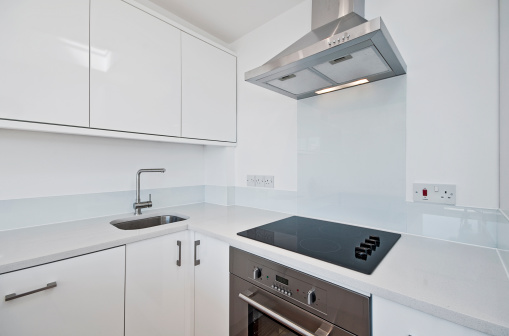The distance between the range hoods and the hob is essential for the effective extraction of cooking vapors and therefore for the air quality in the kitchen. This does not mean that the hood should be positioned as close as possible to the pots, because cooking also releases heat, which can damage electronic components and even create a fire hazard. You shouldn’t be bothered when creating your favorite dishes either: the lower the hood, the less you can see the pots and pans.

Positioning of the range hoods
If you are still imagining your kitchen, pay attention to the following points:
- If you have chosen an exhaust solution, position the hood if possible as close as possible to a front wall, so that the exhaust duct is as short as possible. For a ceiling-mounted hood or an under-counter ventilation system, the exhaust duct must be provided from the start of the project study. The maxim is the same in this case: the shorter, the better.
- The front of the hood should not overhang the worktop, but be set back approx. 5cm.
- If you opt for an evacuation solution, also consider installing an air intake system in the kitchen area. Air renewal is optimal when the air inlet is diametrically opposed to the hood
- It goes without saying that the hood control must be easily accessible. Some manufacturers offer variants of the control integrated into the hood, for example remote controls, apps or external controls.
Minimum distance between range hoods and hob
If the hood is too close to the hob, capture is certainly more effective, but exposure to heat increases the risk of fire and the risk of damage to electronic components.
The minimum distance recommended by manufacturers generally varies between 50 and 75 cm. It is measured from the hob to the underside of the hood. It is specified in the instructions for use and can be requested from the manufacturer if necessary.
Maximum distance between hood and hob

The maximum distance between hood and hob is generally not specified. The rule is simple: the further the hood is from the hob, the lower its efficiency.
Ideal distance between hood and hob
The ideal distance depends on the type of hob, but also on the power and width of the range hoods.
A distinction is made between electric and gas hobs. A gas stove gives off more intense heat and flames that require more distance than an electric stove. The heat from the gas increases the rate of rise of the cooking vapors. On an electric cooker, the cooking vapors rise less quickly, which makes it possible to place the hood closer to the hob.
Minimum distances according to the type of hob:
- electric hob: 600 mm
- gas cooker: 650 mm
- Tiba wood stove: 500 – 1200 mm
- ceiling hood: 900 – 1100 mm
Hood power

The suction power of the hood is an essential factor in the calculation of the height of the hood. A less powerful hood installed 90 cm from the hob will not be able to develop enough power to properly extract the cooking vapors before they disperse in the kitchen. On the other hand, this will not be a problem for a powerful hood adapt to the size of the kitchen.
range hoods width
The rule is simple: the wider the hood is in relation to the width of the hob, the higher it can be position. Indeed, cooking vapors tend to dilute as they rise: this phenomenon is induce by the expansion of the air under the effect of heat. An island kitchen is more exposed to cross currents than a kitchen against a wall. Island hoods must therefore extend further beyond the hob.
- We recommend an overflow angle of 8° for wall hoods, and 15° for island hoods.
- For a distance of 65 to 75 cm between hood and hob, we recommend the following hood widths:
- Hob width up to 75 cm: hood width 90 cm
- Hob width up to 90 cm: hood width 120 cm
If the hood cannot be wider than the hob for reasons of space, it is to your advantage to choose a hood with peripheral extraction. This type of hood is character by a higher suction speed, which generates a laminar flow capable of better capturing the cooking vapors on the edges of the hood.
